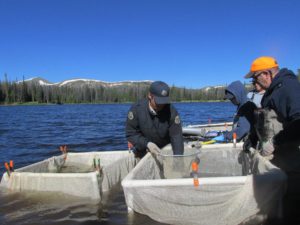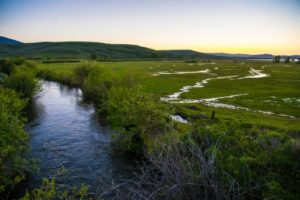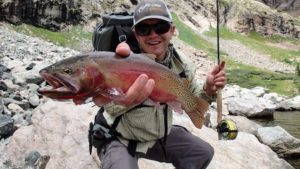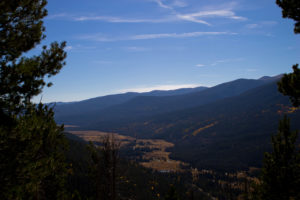Coloradans turned out in force (and in full voice) for a Clean Water for Colorado rally in downtown Denver on Tuesday, August 22. The event was put together by TU and other conservation groups, as well as local outdoor businesses such as RepYourWater, Confluence Kayaks and Down River Equipment. The rally—right across the street from the regional EPA building—sent a clear, loud message to the EPA and elected officials back in D.C.: Coloradans care about clean water. The rally in Denver was in response to the EPA's proposal to repeal the 2015 Clean Water Rule that clarified that smaller seasonal and headwater streams and wetlands are protected under the original Clean Water Act. While the 2015 Rule has been somewhat controversial in certain water circles, the need to maintain clear, logical protections for our headwater streams and wetlands is straightforward. To protect water quality downstream, you need to start from the source upstream.
The message from this week's rally was not to simply support the 2015 rule, but to remind politicians and EPA administrators that a significant percentage of Colorado's economy relies on healthy river ecosystems. As such, there is a clear line that can be drawn between clean water and economic benefits.

Among the speakers was Corinne Doctor of RepYourWater. Her remarks to the crowd echoed the importance of maintaining healthy streams in order to support the economy on which her business relies.
“The Clean Water Rule is essential. We cannot risk having the EPA roll it back," exclaimed Doctor. "That action would result in leaving the majority of the streams, rivers, lakes and wetlands in the lower 48 without protection. We, in the outdoor, and more specifically fishing industry, know that without clean water, we have no business. The sports and hobbies on which our business depends rely on the water to be clean and hospitable habitat for fish and wildlife. For this multi-billion dollar industry, our economy can’t risk that."
Even beyond the outdoor industry, this action could take away slated protections for 60 percent of all U.S. streams, 20 million acres of wetlands and waters that contribute to the drinking water for 1 in 3 Americans.
“We in Colorado need to be sure our voices are heard," said Doctor. "As a seventh generation native of this great state, I can take the outdoor playground that it provides for granted. But we can’t deny that the booming housing market and incredible job market are due in great part to the outdoor accessibility here."
Another iconic Colorado business - craft brewing - lent their support as well. A coalition of Brewers for Clean Water have spoken out for clean water (including Colorado-based breweries Upslope, Odell, Horse & Dragon, Avery, and New Belgium) - submitting formal comments from "Brewers for Clean Water" to the EPA. "Beer is mostly water, so the quality of our source water affects our finished product," they said. "Even small chemical disruptions in our water supply can alter the taste of a brew or influence factors like shelf life and foam pattern ... Protecting clean water is central to our long-term business success."

The rally outside EPA was picked up by a number of news agencies this week - including national outlets such as the Public News Service. The large turnout and media coverage shows that Colorado's outdoor industry and local businesses have a strong voice when it comes to environmental issues that affect us at home.
"Be sure to make your voice heard, for today and for future generations," exclaimed Doctor. "We care about clean water!"
To take a stand for clean water, go to TU's Action Center and raise your voice!


















 In the South Platte basin, Colorado TU and chapters worked to engage young, inner city, girls through the great outdoors by introducing them to fly fishing and conservation; CTU worked with Colorado Parks and Wildlife to reintroduce the Colorado state fish, Greenback Cutthroat Trout, to it's native watershed along the Front Range; Trout Unlimited tackled abandoned mine issues, and various chapters worked to repair their homewater streams from the devastating floods of 2013.
In the South Platte basin, Colorado TU and chapters worked to engage young, inner city, girls through the great outdoors by introducing them to fly fishing and conservation; CTU worked with Colorado Parks and Wildlife to reintroduce the Colorado state fish, Greenback Cutthroat Trout, to it's native watershed along the Front Range; Trout Unlimited tackled abandoned mine issues, and various chapters worked to repair their homewater streams from the devastating floods of 2013. In the Colorado River basin, TU helped secure protections for the Roan Plateau and Thompson Divide from harmful oil and gas development, worked with local ranchers and farmers to improve the health of the Upper Colorado while enhancing agriculture water usage. TU also helped lead the Learning by Doing initiative that, among other things, secured $8 million in funds to protect and restore the Upper Colorado River.
In the Colorado River basin, TU helped secure protections for the Roan Plateau and Thompson Divide from harmful oil and gas development, worked with local ranchers and farmers to improve the health of the Upper Colorado while enhancing agriculture water usage. TU also helped lead the Learning by Doing initiative that, among other things, secured $8 million in funds to protect and restore the Upper Colorado River. In the Rio Grande basin, Trout Unlimited worked to protect the Great Sand Dunes Cutthroat from potential changes in the environment. The Rocky Mountain Flyathlon came to Saguache for the annual race and fishing events that help raise money for Colorado TU's work in protecting native trout and their habitats. The local chapter and Trout Unlimited also worked to repair sections of the Conejos and ensure that winter flows were hospitable for trout.
In the Rio Grande basin, Trout Unlimited worked to protect the Great Sand Dunes Cutthroat from potential changes in the environment. The Rocky Mountain Flyathlon came to Saguache for the annual race and fishing events that help raise money for Colorado TU's work in protecting native trout and their habitats. The local chapter and Trout Unlimited also worked to repair sections of the Conejos and ensure that winter flows were hospitable for trout. TU staff along with Grand County and a number of environmental organizations discouraged the leasing of these parcels that were close to both the Colorado River and Rocky Mountain National Park. These areas also contained cutthroat trout habitat. TU and partners commented on the potential impact to the wildlife resources and recreation in the area to the BLM throughout the NEPA process. The other organizations who commented on these potential leases played a large role in the removal of these parcels, but the sportsmen’s perspective that TU provides seemed to be especially influential in many of these efforts.
TU staff along with Grand County and a number of environmental organizations discouraged the leasing of these parcels that were close to both the Colorado River and Rocky Mountain National Park. These areas also contained cutthroat trout habitat. TU and partners commented on the potential impact to the wildlife resources and recreation in the area to the BLM throughout the NEPA process. The other organizations who commented on these potential leases played a large role in the removal of these parcels, but the sportsmen’s perspective that TU provides seemed to be especially influential in many of these efforts.
